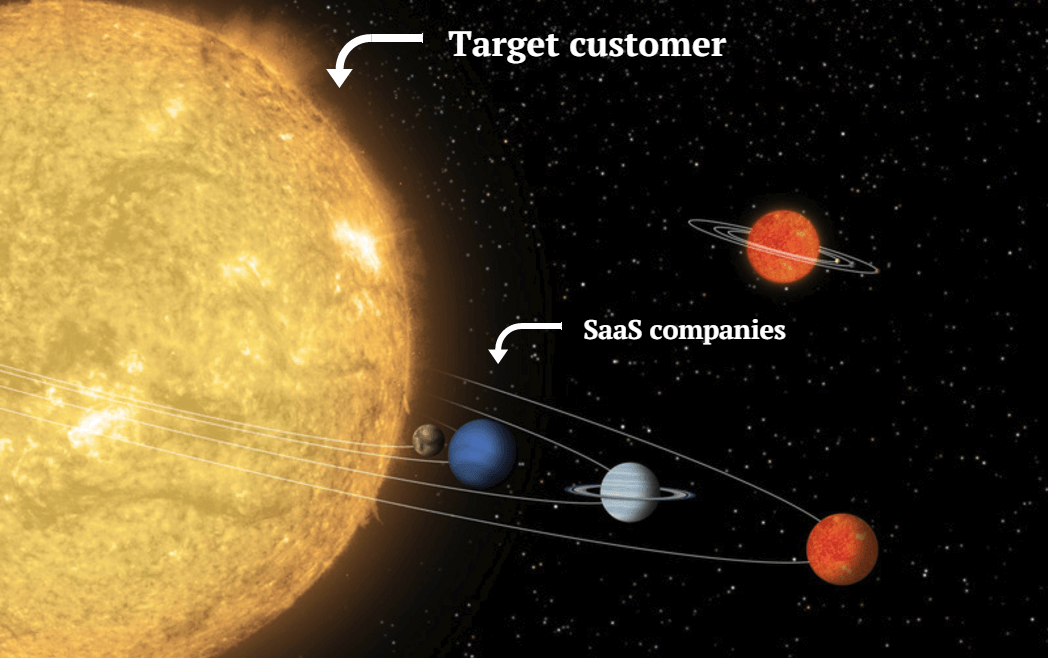New SaaS trends are appearing and significantly influencing companies. They also determine their and the competitors’ actions.
At the same time, more and more SaaS companies are emerging onto the market as the concept of SaaS is becoming increasingly popular. The competition in the SaaS industry is proportionally growing in response to its popularity.

In this article, we’ve gathered together the hottest SaaS trends that will define the industry in 2017.
Knowledge of these trends will help SaaS businesses advance considerably and cut through the competition.
How Can Kraftblick Help Your Software Company?

- We build marketing strategies from scratch and fix existing ones. More about that here.
- We provide consultations to company owners, directors, heads of marketing and sales, marketers. This is how we do it.
See you soon 🙂
The Concept of SaaS Will Spread Further
SaaS itself is currently the hottest trend. The SaaS market is booming and will continue to expand rapidly.

More and more cloud-based services are appearing as companies want to leverage the cloud’s numerous benefits.
According to a Cisco white paper “Cisco Global Cloud Index: Forecast and Methodology, 2015–2020”, 74% of all cloud workloads are going to be SaaS-based by 2020 compared to 65% in 2015.
Forrester Research has predicted that by 2020 the SaaS industry will be generating more than $130 billion in annual revenue compared to about $40 billion in 2016.
Therefore, taking into account the growth of the SaaS market, businesses should be ready for greater competition and strive to employ the emerging trends in the industry.
A Customer-Centric Approach Will Rule the Business
Companies have long ago understood the benefits of a customer-centric approach. Today, customers rule the way we do business.

This trend provides advantages to SaaS businesses in the following two ways:
1. A customer-centric approach helps your company build strong relationships with both potential and existing customers so that they may trust and rely on you. As a result, your prospects are more willing to buy your solutions, and the selling process becomes much easier.
According to Zendesk, 62% of B2B customers purchased more after they had a good customer experience.
2. As your customers come to know and trust your company, they are more likely to stay with you instead of switching to an unknown company. Consequently, excellent customer relationships help increase customer retention which also contributes to revenue growth.
According to studies by Bain & Company, along with Earl Sasser of the Harvard Business School, if customer retention is increased only by 5%, a company may achieve a revenue growth of 95%.
Moreover, in 2017, companies should place a particular emphasis on the enhancement of a customer-centric approach and make it their top priority.
The Focus Will Be Mobile-First
The usage and popularity of mobile technologies is enormous, and businesses need to think about a mobile-first instead of a mobile-friendly approach.

It is estimated that in 2016 more than 60% of the population worldwide already owned a mobile phone.
However, if your website is not mobile-friendly, today’s mobile users will not tolerate any problems connected with your website or solution. In the realm of harsh competition, companies should do their best to optimize their site for mobile technology.
Google found out that 61% of mobile users are unlikely to return to a website that has accessibility problems. Moreover, 40% of people will use the competitor’s website instead.
Imagine that your company’s website is just like your face – it is the first thing that people see. They will also judge your service on the basis of how convenient it is for them.
For these reasons, make sure your website is mobile-friendly so you don’t lose out on potential customers and lose to the overall competition.
SaaS Content Marketing Will Be Taken More Seriously
SaaS companies already know that content marketing helps significantly boost any business and accomplishes functions such as generating organic traffic, producing leads and many others.
Content marketing is such a powerful tool that in 2017 marketers will place a clear emphasis on it.
 Source: flickr.com
Source: flickr.com
A noted shift in content marketing is that blog posts are becoming longer. People like to read and share comprehensive articles that describe in detail what they need or would like to do.
Backlinko analyzed 1 million Google search results and found out that longer content is ranked higher by Google. As a result, an average word count of the first page on Google is about 1,890.
Buzzsumo’s analysis of more than 100 million articles states that longer content tends to get more social shares than short.
Another point of note is that videos are becoming ever more popular because they draw more attention and bring more leads.
According to Cisco, by 2019 video content will comprise about 85% of all Internet traffic.
Companies understand that a video format is more appealing to their audience than other types of content. So they strive to leverage the benefits of video marketing.
According to Hubspot, 96% of B2B companies use videos in their marketing campaigns. At the same time, 73% state that this contributes to a great ROI.
Videos can be particularly useful when introduced on landing pages because they help get more leads.
Eyeview states that using videos on a landing page can increase conversions by about 80%.
Thus, content marketing is the mechanism that advances SaaS businesses significantly.
Artificial Intelligence Will Be Widely Adopted
Artificial Intelligence (AI) makes a business stand out of the competition and attracts a great deal of attention.
 Source: flickr.com
Source: flickr.com
Today many companies already employ various types of AI in their workflow.
For example, they use machine learning to improve workflow, introduce robots and autonomous agents that sense, learn and make decisions within a physical environment and speed up decision management, automate slow or repetitive working processes, and much more.
Businesses, including tech giants, understand that AI is a game-changing technology that can considerably advance a company.
Salesforce, for example, recently launched their own AI assistant – Einstein. It serves as an autonomous agent helping Salesforce’s clients manage their data. By introducing Einstein, Salesforce hopes to improve customer success.
Above all, AI can improve significantly a company’s productivity and overall performance.
According to a survey conducted by Narrative Science, 80% of the polled business and tech leaders believe that AI improves their employees’ performance.
So, in 2017 introducing AI will help improve your SaaS business and aid in cutting through the competition
Value & Usage-Based Pricing Is Gaining More Popularity
Сustomers truly appreciate pricing that is determined by the value they get from your SaaS solution.
The more they use a product, the more they can understand and appreciate its value and are willing to pay.
Price Intelligently puts it greatly:
“Customers don’t care how much something costs you to make or your competitors; they care how much value they’re receiving at a particular price.”
Pricing based on value and usage also provides a number of benefits:
The Freemium Model Will Fall from Grace
Freemium can ideally work for large businesses that have a sizeable audience.
However, it is not the best variant for growing B2B businesses due to two reasons.

1. Customers using a freemium model tend to view your product as a free one.
People become used to receiving your service free of charge, so they are not inclined to pay for such a product.
Consequently, they will see less value in your product.
Price Intelligently says,
“Freemium conditions can lower your customers’ perceived value below 40% of the product’s list price.”
2. A freemium model won’t help your company boost the revenue.
It works best only as a marketing strategy and can be used, for example, to stimulate hype and word-of-mouth.
But again, people may be not willing to pay for a product that they can get for free.
Lincoln Murphy, a customer success consultant, states that 97% of freemium users will never transfer to a paid plan.
Therefore, in 2017, SaaS small and medium businesses will need to reconsider their approach to a freemium model as they can potentially spend more on its maintenance than what its worth and in the end they may go bankrupt.
Conclusions
SaaS trends change every year, and it is very important to be aware of them and keep up with the current situation on the market so as not to lose to the competition.
So, here is what we expect to see in the SaaS industry in 2017:
- The SaaS concept will gain even more popularity which will result in increased competition between SaaS businesses.
- The customer-centric approach will influence the SaaS industry to a greater degree as companies begin to understand its numerous benefits.
- The focus of SaaS companies should be shifted from a mobile-friendly to mobile-first approach.
- Content marketing will be taken more seriously; this includes writing longer blog posts and giving more attention to video marketing.
- Companies will introduce Artificial Intelligence to stand out of the competition.
- Value and usage-based pricing models will become more widespread among SaaS businesses because the more they use a product, the more they can understand and appreciate its value and are willing to pay.
- The freemium model will see a decrease in popularity as its potential disadvantages are more critical than advantages.
What are your expectations for 2017? Share your thoughts with us in the comments section.